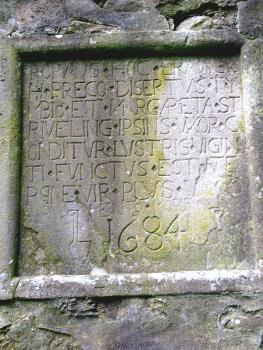Item Details

Work details
- Title
- Strowan Parish Church (also known as Struan)
- Work OCR text
SUMMARY DESCRIPTION
The eastern half of a rectangular church has been retained in use as a burial enclosure for the Stirling of Strowan family, with the western half remaining in evidence as little more than ill-defined earth mounds
HISTORICAL OUTLINE
The church of Strowan first appears as a free parsonage in Bagimond’s Roll in 1274-5.(2) It is possible that the parish was a comparatively recent erection, for in the early 1280s when Máel Iosa or Malise, son of Malise, earl of Strathearn, granted the advowson of Strowan to the canons of Inchaffray, he included in the grant the land on which the church was built and the piece of ground which he had given as dower for it at the time of its dedication.(3) Although no record survives of such a grant, it appears that full appropriation of the church to Inchaffray quickly followed the gift of the advowson and the cure seems thereafter to have been served by a vicar pensionary.(4) Vicars of Strowan are recorded in 1477, 1484, 1532 and 1534/5.(5) The vicarage of Strowan, presumably the vicarage pensionary, was held together with the vicarage of Logie-Atheron by James Chisholm at the time of the Reformation.(6)
ARCHITECTURAL ANALYSIS
It is thought that Strowan was the original home of the Crieff Burgh Cross.
The abandoned parish church site is an irregularly shaped churchyard to the south-east of Strowan House. Following the construction of a new church on a different site for the united parishes of Strowan and Monzievaird in 1803-4, the church was reduced in size by the demolition of the western half, and the adaptation of the eastern half as a burial enclosure for the Stirling of Strowan family. The north and south walls and crow-stepped east gable of the retained half of the building stand to full height, and a low wall and fence were constructed to contain the enclosure on its west side.
The building as it now stands is constructed of grey rubble with minimal dressings, and is aligned from east-north-east to west-south-west; it has a width of 7.5 metres. The length of the retained portion is 11.34 metres, but the original total length of the church appears to have been in the order of 20.74 metres. At the centre of the retained section of the south wall is a rectangular doorway with a segmental rear-arch and chamfered jambs and lintel, which is flanked on each side by a rectangular window. Rising into the gable of the east wall is a rectangular window with chamfered margins, within a segmental rear-arch. Internally the gable is set back from the lower face, and there are two square recesses in the wall, one at the centre of the wall and another at a higher level at the north end of the wall.
A number of decorated or inscribed stones have been set into the masonry. Externally, below the east window, is a stone emblazoned with what appears to be the arms of the Murrays of Strowan, set within a quatrefoil. This has the appearance of being of late medieval date. Set within the masonry of the internal north wall is a carefully worked slab carved in low relief commemorating John Murray of Strowan, who died in 1541. A secondary insertion in the external masonry of the east wall commemorated Margaret Stirling, who died in 1684.
The church has generally been deemed to be of early post-Reformation date, and this is likely to be the case for many of the visible architectural features. Nevertheless, the plan and alignment point to a medieval origin for the form of the church, and the incorporation in the masonry of two carved stones of late medieval date strongly suggest that there is medieval fabric still in place.
The parish was united with that of Monzievaird at a date before 1662, and the church was presumably subsequently abandoned for worship.
NOTES
1. Cockburn, Medieval Bishops of Dunblane, 9.
2. SHS Misc, vi, 54, 71.
3. Inchaffray Charters, no CXII.
4. Cowan, Parishes, 193.
5. NAS GD196/2, GD279/7, GD112/2/133/1 no 1; RMS, iii, no 1257.
6. Kirk (ed.), Book of Assumptions, 313.
BIBLIOGRAPHY
Charters, Bulls and other Documents relating to the Abbey of Inchaffray, 1908, (Scottish History Society), Edinburgh, no CXII.
Cockburn, J.H., 1959, The Mediaeval Bishops of Dunblane and their Church, Edinburgh, 9.
Cowan, I.B., 1967, The parishes of medieval Scotland, (Scottish Record Society), Edinburgh, 193.
Dunlop, A.I., 1939, ‘Bagimond’s Roll, statement of the tenths of the kingdom of Scotland’ Miscellany of the Scottish History Society, vi, 1-77, at 54, 71.
Hall, M., Forsyth, K., Henderson, I., Scott, I, Trench-Jellicoe, R., Watson, A., 2000. 'Of makings and meanings: towards a culural biography of the Crieff Burgh Cross, Strathearn, Perthshire, Tayside and Fife Archaeological Journal, vi, 154-188.
Kirk, J., 1995, The books of assumption of the thirds of benefices, (British Academy) Oxford, 313.
Registrum Magni Sigilli Regum Scotorum, 1883, iii (1513-46), Edinburgh, no 1257.
Royal Commission on the Ancient and Historical Monuments of Scotland, Canmore database.
Statistical Account of Scotland, 1791-9, ed. J. Sinclair, Edinburgh, viii (1793), 574.
- Work Additional Notes
Dedication: St Ronan(1)
Diocese: Diocese of Dunblane
County: County of Perthshire
Council: Perth and Kinross Council
OS: NN 8205 2118
Image details
- Description
- 5. Strowan Church, exterior, E wall, monument
- Full Image Dimensions (WxH)
- 3000x4000 pixels
- Accession Number
- IDB-124289-000897
- Collection
- Corpus of Scottish medieval parish churches








